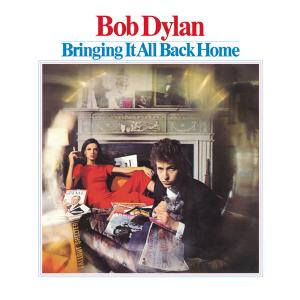
Bringing It All Back Home (1965)

1. Subterranean Homesick Blues
2. She Belongs to Me
3. Maggie's Farm
4. Love Minus Zero/No Limit
5. Outlaw Blues
6. On the Road Again
7. Bob Dylan's 115th Dream
8. Mr. Tambourine Man
9. Gates of Eden
10.It's Alright, Ma (I'm Only Bleeding)
11.It's All Over Now, Baby Blue
With Bringing It All Back Home, Dylan didn’t merely change musical direction—he changed the rules. Released in 1965, the album marked the first major rupture between Dylan and the folk purists who had championed his early work. For some, it was apostasy. For others, the birth of a new idiom. Either way, it was a line in the sand: Dylan had gone electric.
Looking back, the controversy surrounding Dylan’s use of electric instruments seems almost quaint. The Greenwich Village elite—whose adoration was as much about exclusivity as artistry—reacted not only to the sound but to the sense that “their” Dylan was no longer theirs. Yet the shift was far less radical than some made it out to be. Structurally, many of the songs on Bringing It All Back Home retained the lyrical poise and melodic clarity of earlier works. And, as if to ease the transition, Dylan reserved the entire second side for acoustic performances, effectively bridging old and new.
The album opens with Subterranean Homesick Blues, an extraordinary collision of Beat poetry, rock and roll, and streetwise absurdism. A stream-of-consciousness firecracker, it set the tone for what would follow: literate, elliptical, and laced with menace and wit. From that point on, Dylan moves confidently through what is arguably the finest set of songs he had released to date. Maggie’s Farm and Outlaw Blues continue the electric assault, while She Belongs to Me offers a more lyrical counterpoint, a quietly possessive ode couched in dreamlike imagery.
Side two reverts to the acoustic palette familiar to Dylan’s early audience, but the tone remains changed. Mr. Tambourine Man is a kaleidoscope of surrealist vision and longing, later immortalized (and diluted) by The Byrds. It’s All Over Now, Baby Blue and Love Minus Zero/No Limit distill romantic disillusionment into crystalline verse. Meanwhile, Gates of Eden and It’s Alright, Ma (I’m Only Bleeding) represent Dylan at his most apocalyptic—raging against hypocrisy, violence, and self-delusion with venomous clarity.
For all its thematic darkness, there is humor here too. Bob Dylan’s 115th Dream famously opens with a botched take and Dylan dissolving into laughter, an inclusion that manages to humanize the myth without undermining it. The completed take is a bizarre, extended allegory that somehow manages to be both hilarious and unnerving.
By the end of Bringing It All Back Home, there could be no mistaking that Dylan had crossed into uncharted territory—not only for himself, but for the entire landscape of popular music. The album was not simply a transition; it was an upheaval, and it signaled the start of the most creatively explosive period of his career. Overlooked in some corners due to the flashier headlines of the era, it is in fact one of Dylan’s most cohesive and innovative works—perhaps the first great album of the rock era in the fullest sense.
Go back to the main page
Go To Next Review